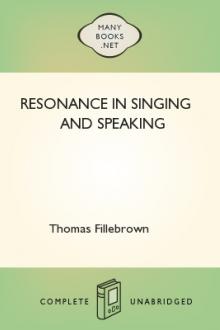Resonance in Singing and Speaking by Thomas Fillebrown (book suggestions .TXT) 📕

- Author: Thomas Fillebrown
- Performer: -
Book online «Resonance in Singing and Speaking by Thomas Fillebrown (book suggestions .TXT) 📕». Author Thomas Fillebrown
As an illustration of sympathetic resonance without contact, sing forcibly a tone that is within easy range, and at the same time silently hold down the corresponding key of the piano. On ceasing to sing you will hear the tone sounding in the piano. This may be further illustrated by playing on the open string of one violin while another, tuned to the same pitch, rests untouched near by. Through sympathetic resonance the corresponding string of the second violin will vibrate and sound its note. The louder the first violin is played the louder will be the sympathetic tone of the second.
The deep pedal-tones of a church organ often induce sympathetic resonance that may be felt beneath the feet of the listener. One writer, a singer, speaks of living in the same house with two deaf-mutes. He lodged on the first floor, they on the third. One day, meeting at luncheon, one of the deaf-mutes told the singer that he had begun practice earlier that morning than usual. Surprised, the writer asked how he knew. The deaf-mute replied that they always knew when he was singing because they felt the floor of their room vibrate.
If tone vibrations can be transmitted so readily throughout a house, it is not difficult to understand how easily the vibrations of bone and tissue can be transmitted until the whole framework of the body responds in perceptible vibration.
It is said that Pascal at the age of twelve wrote a dissertation on acoustics suggested by his childish discovery that when a metal dish was struck by a knife the resulting sound could be stopped by touching the vibrating dish with a finger.
With this in mind it is not difficult to understand how compression of the human instrument by the pressure of tight clothing without, or by false muscular tension within, must interfere with its free vibration and so rob the produced tone of just so much of perfection.
From these experiments we can understand that, while the tones of the voice are initiated by or at the vocal cords, the volume and character of the tones are dependent upon resonance,—the vibration of the air in the various resonance chambers of the body, together with the sympathetic vibration of the walls of these chambers and the bony framework that supports them.
In respect to resonance, as in other respects, the human voice is far superior to all other instruments, for their resonators are fixed and unchanging, while the human resonator is flexible,—in Helmholtz's words "admits of much variety of form, so that many more qualities of tone can be thus produced than on any instrument of artificial construction."
We are now prepared to realize the error of the common notion that loudness of tone is due entirely to increase of breath pressure on the vocal cords. Simple experiments with the tuning-fork have shown that while the volume of sound it gives forth is due in part to the amplitude of its vibrations, its loudness is chiefly due to the character of the resonance provided for it.
The larger the resonance chamber the greater is its reinforcing capacity. The largest air chamber in the body is the chest, which serves not only as a wind-chest, but as a resonance chamber. The necessity for chest expansion, therefore, is not, as generally supposed, merely for air, but to increase its size as a resonance chamber.
In view of the laws of tone, how great is the common error of speaking of the larynx as if it alone were the vocal organ, when the principal vibrations are above the vocal cords in the chambers of resonance!
Since the musical value, the beauty of tone, as well as its volume, comes only from right use of the resonator, our principal business must be the acquiring control of the vibratory air current above the larynx. The acquirement of this control involves the proper focusing or placing of the tone, with the free uncramped use of all the vocal organs; power will then take care of itself.
CHAPTER VII Head and Nasal ResonanceOf the four component factors in the production of speech and song, the first, the motor, has been considered in Chapter III, and the second, the vibrator, in Chapter I.
In one respect there is marked contrast between these two factors. Until right habits are so thoroughly formed that the singer's breathing is automatically controlled, conscious effort is necessary, while the action of the vibrator, the vocal cords, is involuntary, not subject to conscious control.
The subtle adjustments of the delicate mechanism of the larynx belong to the realm of reflex action—to a spontaneous activity that, left unhindered, does its part in perfect nicety.
The vocal cords must, in their action, be free from the disturbance of uncontrolled breath action below them, or the hindrance due to misdirected effort above them. To direct consciousness to the vocal cords is to cramp them and prevent that free vibration and that perfect relaxation of the throat without which pure tone and true pitch are impossible.
As a surgeon I well know the value of thorough anatomical knowledge, but from the singer's standpoint I cannot too strongly emphasize the unwisdom of directing the attention of sensitively organized pupils to their vocal mechanism by means of the laryngoscope. This instrument belongs to the physician, not to the singer.
The importance of the third factor, the resonator, has been considered in Chapter V, on Resonance, but the fourth element in voice production, articulation, is so coördinated to resonance that the significance and primacy of the latter are too often overlooked.
Placing or "focusing the voice" I have found to be chiefly a matter of control and use of the resonator, consisting of chest, pharynx, mouth, and the nasal and head cavities.
A tone lacking in resonance is ineffective,—devoid of carrying power,—is diffuse and unfocused; while a resonant tone, no matter how soft dynamically, has carrying power and is focused in its vibration.
Now "voice placing" depends primarily on correct vowel placing, which in turn depends on proper adjustment of the resonators, which again depends chiefly on the positions and motions of the organs of articulation. The interdependence of tone quality and pronunciation is therefore obvious.
Constant emphasis must be laid upon the fact that focusing a tone is a matter of resonance, and that perhaps the most important element in this is nasal resonance. In this country, particularly, teachers have, in their desire to overcome the too common nasal twang, mistakenly sought to shut out the nasal chamber from all participation in speech and song.
There are those who, partly recognizing the importance of head resonance, would secure it while ignoring nasal resonance. It is impossible to secure head resonance in this fashion, for it is only through free nasal resonance that the coördinate resonance in the air sinuses above the nasal cavity and connected with it can be established.
The fear of nasal twang and failure to distinguish between it and true nasal resonance has been the stumbling block. They are very different,—one is to be shunned, the other to be cultivated. The first is an obvious blemish, the second is an important essential of good singing.
Nasal tones are caused by a raised or stiffened tongue, a sagging soft palate, a stiffened jaw, or by other rigidities that prevent free tone emission and which at the same time—note this—prevent true nasal resonance.
As tone, or vocalized breath, issues from the larynx, it is divided into two streams or currents by the pendent veil of the soft palate. One stream flows directly into the mouth, where it produces oral resonance; the other stream passes through the nasopharynx into the hollow chambers of the face and head, inducing nasal and head resonance.
It is commonly supposed that tone passing in whole or in part through the nasal cavities must be nasal in quality; whereas a tone of objectionable nasal quality can be sung equally well with the nostrils either closed or open.
Browne and Behnke state the matter thus: "However tight the closure of the soft palate may be, it is never sufficient to prevent the air in the nasal cavities being thrown into co-vibrations with that in the mouth. These co-vibrations are, in fact, necessary for a certain amount of the brilliancy of the voice, and if they are prevented by a stoppage of the posterior openings of the nasal passages, the voice will sound dull and muffled. This is of course due, to an absence of nasal resonance, and must on no account be described as nasal twang. It is, indeed, the very opposite of it."
Nasal tone quality and nasal resonance must not be confounded. A nasal tone is constricted, while a tone with nasal resonance is free. Again, a tone may be unmarred by the nasal quality, yet if it lacks nasal resonance it lacks vibrancy, carrying power.
Nasal tones are produced, not because the vibrations pass through the nasal passage, but because they are obstructed in their passage through them. A nasal tone is always a cramped tone, due to impediment, tension, or muscular contraction, particularly in the nasopharynx.
The congestion and consequent thickening of the mucous membrane lining the cavities of the nose and head, resulting from a cold, make the tone muffled and weak, owing to the inability of the parts to respond to the vibrations and add to the tone normal nasal resonance.
The elder Booth (Junius Brutus), about 1838, suffered from a broken nose which defaced his handsome visage and spoiled his splendid voice. His disability was so great that afterward he seldom played. That the cause of this impairment of Booth's voice was due to the contraction and more or less complete obstruction of the nasal passages is too evident to call for comment.
Many singers have sweet but characterless voices that lack the fulness, power, and ring they might have because they fail to avail themselves of the augmenting power of the resonance cavities. The singer must learn to habitually use all of the resonance cavities and use them simultaneously.
Lilli Lehmann, in How to Sing, says that, "although the nasal sound can be exaggerated,—which rarely happens,—it can be much neglected,—something that very often happens." The context makes clear that what in the English translation of the great singer's book is called "nasal sound" is exactly what we term nasal resonance.
After charging the monotonous quality or lack of color in the voice of a famous opera star to lack of nasal resonance, Madame Lehmann speaks of the consummate art of Marcella Sembrich who "in recent years appears to have devoted very special study to nasal resonance, whereby her voice, especially in the middle register, has gained greatly in warmth." She says further that nasal resonance "cannot be studied enough. It ought always to be employed." "How often," she says, "have I heard young singers say, 'I no longer have the power to respond to the demands made upon me,' whereas the trouble lies only in the insufficient use of the resonance of the head cavities."
From the foregoing, the conclusion follows that the head vibrations are not only an essential element, but that nasal resonance is a most important element in imparting to tone its brilliance and carrying power. Without thought of the mechanism of how nasal resonance is produced, the singer has control over it by direct influence of the will. The tones, low as well as high, should seem to start in the nose and head, and the vibrations of the perfect tone can be plainly felt upon any part of the nose and head. Without the head vibrations no tone can be perfect, for nothing else will compensate





Comments (0)